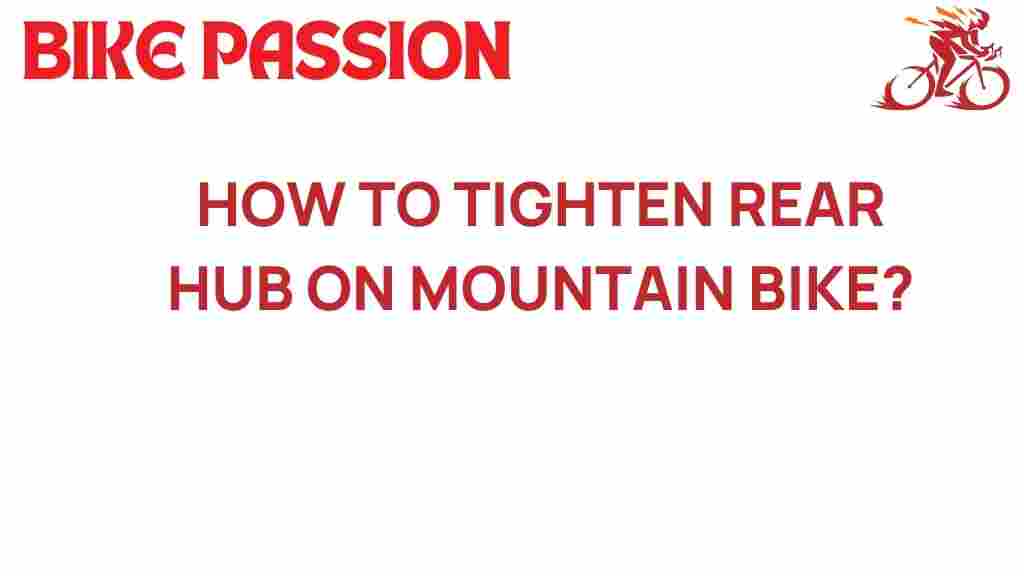Mastering Rear Hub Tension: A Mountain Biker’s Guide
When it comes to mountain biking, having a well-maintained bike can significantly enhance your riding experience. One of the most critical components of your mountain bike is the rear hub. Proper rear hub maintenance not only ensures smooth operation but also extends the lifespan of your bike and improves overall performance. In this comprehensive guide, we’ll explore rear hub maintenance, adjustments, and essential cycling tips to keep your bike in top shape.
Understanding the Rear Hub
The rear hub is a fundamental part of your mountain bike’s wheel system. It connects the wheel to the bike frame and houses the axle, bearings, and freehub mechanism. A well-functioning rear hub is crucial for ensuring efficient power transfer and overall bike performance. Here are some key components of the rear hub:
- Axle: The central rod that connects the wheel to the bike frame.
- Bearings: Components that allow the hub to spin smoothly.
- Freehub: A mechanism that allows the rider to coast without pedaling.
Why Rear Hub Maintenance Matters
Neglecting rear hub maintenance can lead to a host of problems, including:
- Increased friction, resulting in poor bike performance.
- Wear and tear on the bearings, leading to costly repairs.
- Reduced efficiency in power transfer while pedaling.
- Potential safety hazards if components fail during a ride.
To avoid these issues, regular bike maintenance is essential. This guide will help you master the art of rear hub tension and adjustment.
Step-by-Step Process for Rear Hub Adjustment
Adjusting the rear hub is a straightforward process that you can do at home with some basic tools. Follow this step-by-step guide to ensure your hub is properly adjusted.
Tools You’ll Need
- 1-2 sets of cone wrenches
- Grease or lubrication
- Cleaning cloths
- Bike stand (optional)
- Torque wrench (for precise adjustments)
Step 1: Remove the Rear Wheel
To access the rear hub, start by removing the rear wheel from your mountain bike:
- Shift the chain onto the smallest rear cog.
- Unfasten the quick release or use a wrench to loosen the axle nuts.
- Carefully lift the wheel out of the dropouts.
Step 2: Inspect the Rear Hub
Before making adjustments, inspect the rear hub for any signs of damage or excessive wear:
- Check for play in the hub by spinning it and feeling for roughness.
- Look for any visible damage or debris.
- Make sure the freehub engages and disengages smoothly.
Step 3: Adjusting Hub Tension
Once you’ve inspected the hub, it’s time to adjust the tension:
- Using the cone wrenches, loosen the locknut on the non-drive side of the hub.
- Turn the cone to adjust the bearing tension. Clockwise will tighten, counterclockwise will loosen.
- Feel for resistance while spinning the hub. It should spin freely but not have excessive play.
- Once you’ve achieved the correct tension, hold the cone in place and tighten the locknut.
Step 4: Reassemble the Wheel
After adjusting the hub, reassemble the wheel:
- Insert the wheel back into the dropouts.
- Secure the axle with the quick release or tighten the nuts.
- Shift through the gears to ensure proper alignment and function.
Step 5: Test Ride
Before heading out on a long ride, take a short test ride to ensure everything is functioning correctly. Pay attention to:
- Any unusual noises from the rear hub.
- How the bike feels while pedaling.
- Shifting performance.
Troubleshooting Common Rear Hub Issues
Even with regular maintenance, you may encounter some issues with your rear hub. Here are some common problems and troubleshooting tips:
Problem 1: Hub is Noisy
If you hear grinding or clicking noises coming from the rear hub, it may indicate insufficient lubrication or worn bearings. Solution: Clean and lubricate the hub, and replace any worn bearings as necessary.
Problem 2: Hub has Excessive Play
Excessive play in the hub can lead to poor bike performance and potential safety hazards. Solution: Re-adjust the hub tension as outlined in the adjustment steps above.
Problem 3: Freehub Not Engaging
If the freehub isn’t engaging properly, it may be dirty or damaged. Solution: Clean the freehub mechanism or replace it if necessary.
Problem 4: Wheel Wobble
A wobbly rear wheel can be caused by a misaligned hub or a bent rim. Solution: Check the alignment of the hub and true the wheel if needed.
DIY Bike Maintenance Tips
Maintaining your mountain bike doesn’t have to be a daunting task. Here are some DIY bike maintenance tips to keep your bike in optimal condition:
- Regular Cleaning: Clean your bike after every ride to remove dirt and grime.
- Lubrication: Keep your chain and moving parts well-lubricated to prevent wear.
- Check Tire Pressure: Ensure your tires are properly inflated for better traction and performance.
- Inspect Brake Pads: Regularly check your brake pads for wear and replace them if necessary.
- Keep Tools Handy: Having a basic set of tools can help you perform quick repairs on the go.
Conclusion
Mastering rear hub tension is an essential skill for any mountain biker. With proper maintenance and adjustments, you can ensure your bike performs at its best, enhancing your riding experience. Regularly inspect and adjust your rear hub to prevent issues and extend the life of your bike. Embrace the challenge of bike repair and enjoy the freedom of cycling with confidence!
For more information on bike mechanics and maintenance, check out this helpful resource. And for expert tips on cycling, visit this website.
This article is in the category Maintenance and created by BikePassion Team
